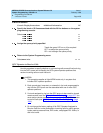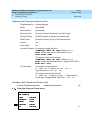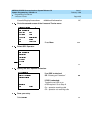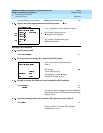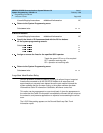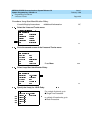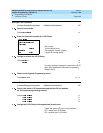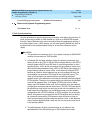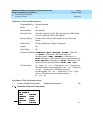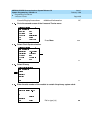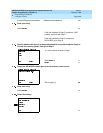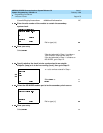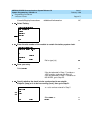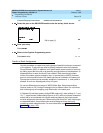
MERLIN LEGEND Communications System Release 6.0
System Programming
555-660-111
Issue 1
February 1998
Programming Procedures
Page 4-66Lines and Trunks
4
Console/Display Instructions Additional Information PC
Return to the System Programming menu.
Select
twice.
Clock Synchronization 4
Use this procedure to specify the primary, secondary, and tertiary clock source. A
clock source may be either a 100D module or a port on an 800 NI-BRI module.
See the
Feature Reference
for more information about the appropriate setting. If
the clock is taken from a 100D module, you can also specify whether the clock is
synchronized to the outside endpoint (loop) or to the clock reference source
(local).
NOTES:
1. This procedure is necessary only if your system includes an 800 NI-BRI
module or more than one 100D module.
2. In Release 6.0 and later systems, assign the primary, secondary, and
tertiary clocks to any DS1 or BRI line that connects directly to the PSTN
at each system with DS1 and BRI lines. In prioritizing sources of clock
synchronization, a DS1 facility connecting to a long-distance carrier’s toll
office should take precedence over a DS1 or BRI facility connecting to a
local exchange carrier’s central office. In the absence of digital PSTN
facilities at a switch, either because they are not equipped or they are
not available, use a tandem PRI board for the loop clock source. The
clock synchronization can be derived from tandeming switches if
another switch in the network is connected to correctly functioning digital
PSTN facilities. Therefore, the system deriving its clock from the tandem
trunk will be assigned loop. If no digital PSTN trunks exist for either
reason and PRI tandem trunks exist, the hub system for a star network
configuration should provide the clock source. The DS1 PRI lines should
be specified as local at the hub and loop at the non-hub switches. For a
linear network configuration or a combination linear and star network
configuration with no PSTN facilities, or PSTN facilities only at a single
switch, all systems not connected to the PSTN facilities and not acting
as a hub and connected by PRI tandem trunks will be set to loop for
clock synchronization sources using the tandem trunks. In the absence
of any external digital facilities, there can be only one active local clock
in the private network.
3. The administration of clock synchronization is not related to the
administration of the PRI switch type or PRI tandem trunk mode.



